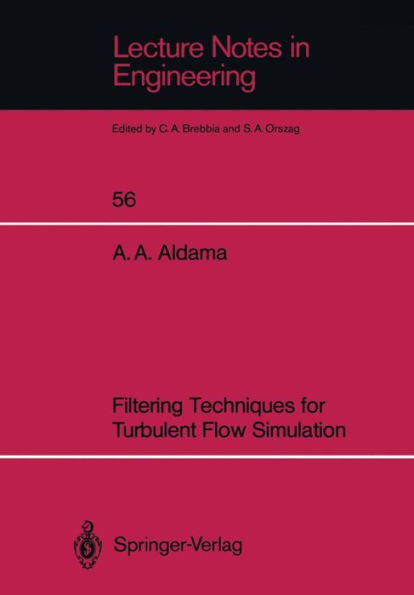5
1


Paperback(Softcover reprint of the original 1st ed. 1990)
$109.99
-
PICK UP IN STORECheck Availability at Nearby Stores
Available within 2 business hours
Related collections and offers
109.99
In Stock
Overview
1. 1 Scope of the Study The detailed and reasonably accurate computation of large scale turbulent flows has become increasingly important in geophysical and engi neering applications in recent years. The definition of water quality management policies for reservoirs, lakes, estuaries, and coastal waters, as well as the design of cooling ponds and solar ponds, requires an ade quate quantitative description of turbulent flows. When the diffusion of some tracer (be it active, such as temperature or salinity, or passive, such as dissolved oxygen) is of relevance to a specific application, the proper determination of the effects of turbulent transport processes has paramount importance. Thus, for instance, the proper understanding of lake and reservoir dynamics requires, as a first step, the ability to simulate turbulent flows. Applications in other areas of geophysical research, such as meteorology and oceanography are easily identified and large in number. It should be stressed that, in this context, the analyst seeks predictive ability to a certain extent. Accordingly, the need for simulation models that closely resemble the natural processes to be represented has recently become more evident. Since the late 1960s considerable effort has been devoted to the development of models for the simulation of complex turbulent flows. This has resulted in the establishment of two approaches which have been, or 2 have the potential for being, applied to problems of engineering and geophysical interest.

Product Details
| ISBN-13: | 9783540521372 |
|---|---|
| Publisher: | Springer Berlin Heidelberg |
| Publication date: | 02/14/1990 |
| Series: | Lecture Notes in Engineering , #56 |
| Edition description: | Softcover reprint of the original 1st ed. 1990 |
| Pages: | 397 |
| Product dimensions: | 6.69(w) x 9.53(h) x 0.03(d) |
Table of Contents
1 Introduction.- 1.1 Scope of the Study.- 1.2 Report Outline.- 2 Turbulence Modeling.- 2.1 The Nature of Turbulent Flows.- 2.2 Conventional Turbulence Modeling.- 2.3 Large Eddy Simulation.- 2.4 Summary.- 3 Two-Scale Filtering Approach Theory.- 3.1 Introduction.- 3.2 Space-Time Filtering Approach.- 3.3 The Leonard Approximation in the STF Context.- 3.4 The Approximation of the Cross Terms.- 3.5 The Asymptotic Nature of the Leonard Approximation.- 3.6 The Asymptotic Nature of the Approximation of the Cross Terms.- 3.7 Fourier Space Theory.- 3.8 Filtering Effect of Discrete Approximations.- 3.9 Closure Model.- 3.10 Summary.- 4 Three-Scale Filtering Approach Theory.- 4.1 Introduction.- 4.2 Three-Scale Approach.- 4.3 Macroscale Dynamics.- 4.4 Mesoscale Dynamics.- 4.5 Relationship between Two- and Three-Scale Approaches.- 4.6 Closure Model.- 4.7 Summary.- 5 Direct Simulations of Periodic Burgers’ Flow.- 5.1 Introduction.- 5.2 Burgers’ Equation as a Mathematical Model of Turbulence.- 5.3 Shock Development and Energy Equation for Free Burgers’ Flow.- 5.4 Design of Numerical Experiment for Free and Periodic Burgers’ Flow.- 5.5 Computation of Spectral Statistics.- 5.6 Filtering of Instantaneous Variables.- 5.7 Generation of Initial Conditions.- 5.8 Numerical Scheme.- 5.9 Numerical Stability Analysis.- 5.10 Results for Free and Periodic Burgers’ Flow.- 5.11 Forced and Periodic Burgers’ Problem.- 5.12 Generation of Random Forcing.- 5.13 Results for Forced and Periodic Burgers’ Flow.- 5.14 Summary.- 6 Numerical Experiments with Two-Scale Filtering Approaches Applied to Periodic Burgers’ Flow.- 6.1 Introduction.- 6.2 LES Approach for Free Burgers’ Flow.- 6.3 STF Approach for Forced Burgers’ Flow.- 6.4 Relationship between LES and STF Approaches.- 6.5 NumericalScheme.- 6.6 Simulation of Space-Filtered (LS) Free Burgers’ Flow.- 6.7 Simulation of Space-Time Filtered (STF) Forced Burgers’ Flow.- 6.8 Summary.- 7 Numerical Experiments with Three-Scale Filtering Approach Applied to Periodic Burgers’ Flow.- 7.1 Introduction.- 7.2 Space-Filtered Macroscale Dynamics.- 7.3 Space-Filtered Mesoscale Dynamics.- 7.4 Numerical Scheme.- 7.5 Simulation of Space-Filtered (Free) Mesoscale Burgers’ Flow.- 7.6 Summary.- 8 Discussion, Conclusion and Recommendations.- 8.1 Conventional Averaging Procedures Versus Filtering.- 8.2 Discussion of Results and Summary of Contributions.- 8.3 Recommendations for Future Research.- Appendix A Implicit Factored — Quadratic Finite Element Formulation of Stf Forced Burgers’ Equation.- Appendix B Implicit Factored — Quadratic Finite Element Formulation of Les-Mesoscale Equation.- References.From the B&N Reads Blog
Page 1 of
